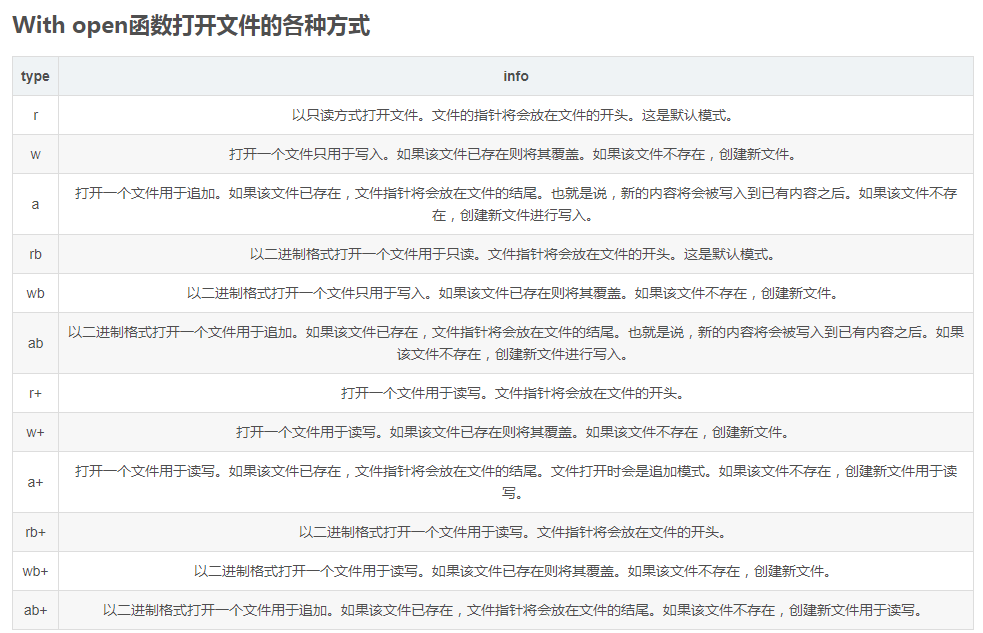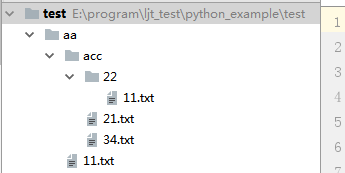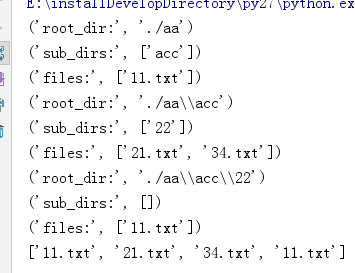python文件操作
Python的open函数文件读写线程不安全,logging模型文件读写线程安全!
工作中遇到的问题:如何在多线程的程序中同时记录日志?
最初图省事,使用了最原始的open函数来写日志,因为开始使用的写文件模式的是追加('a'),发现并没有线程不安全的现象,各个线程的的日志信息都写入到了日志文件中。
后来将写文件模式改成了只写默认('w'),这时候线程不安全的问题就显露出来了,只有一个线程的日志信息被记录。
这时候觉得不能再图省事了,有必要把Python标准库中专用日志模块logging好好学习一下,果然不让人失望,logging是线程安全的。无论是只写模式,还是追加模式,多线程的日志信息都正确的被记录下来了。
以下是测试代码:
def file_io(message,mode): with open('log_test.log',mode) as f: f.write(message) f.write('\n') def logging_io(message,mode): logging.basicConfig(level='DEBUG', filename='log_test1.log', filemode=mode) logging.info(message) if __name__ == '__main__': messages= ['---hello--', '----nihaojlj', '----world%%%%%%%%%%%%%%%%%%'] for m in messages: th = threading.Thread(target=logging_io, args=(m,'a')) th.start()
总结:
- 多线程同时写文件的时候,追加模式('a')貌似并没有线程不安全的现象
- 多线程记录日志信息,还是使用标准库的logging模块吧,它线程安全!专业的事用专业的模块!
获取文件大小:os.path.getsize()
'''获取文件的大小,结果保留两位小数,单位为MB''' def get_FileSize(filePath): filePath = unicode(filePath,'utf8') fsize = os.path.getsize(filePath) fsize = fsize/float(1024*1024) return round(fsize,2)
python读取大文件
最近在学习python的过程中接触到了python对文件的读取。python读取文件一般情况是利用open()函数以及read()函数来完成:
f = open(filename,'r') f.read()
这种方法读取小文件,即读取远远大小小于内存的文件显然没有什么问题。但是如果是将一个10G大小的日志文件读取,即文件大于内存的大小,这么处理就有问题了,会造成MemoryError ... 也就是发生内存溢出。
发生这种错误的原因在于,read()方法执行操作是一次性的都读入内存中,显然文件大于内存就会报错。
解决方法:
这里发现跟read()类似的还有其他的方法:read(参数)、readline()、readlines()
(1)read(参数):通过参数指定每次读取的大小长度,这样就避免了因为文件太大读取出问题。
while True:
block = f.read(1024)
if not block:
break
(2)readline():每次读取一行
while True:
line = f.readline()
if not line:
break
(3)readlines():读取全部的行,构成一个list,通过list来对文件进行处理,但是这种方式依然会造成MemoyError
for line in f.readlines():
....
以上基本分析了python中读取文件的方法,但是总感觉不能达到python中所强调的优雅,后来发现了还有下面的解决方法:
pythonic(我理解的是很python的python代码)的解决办法:
with open(filename, 'r') as flie:
for line in file:
....
对可迭代对象file进行迭代,这样会自动的使用buffered IO以及内存管理,这样就不必担心大文件问题了。
后来,又发现了一个模块:linecache,这个模块也可以解决大文件读取的问题,并且可以指定读取哪一行,
# 输出第2行 text = linecache.getline(filename, 2)
pandas分块读取大数据,避免内存不足
#coding=utf-8 import pandas as pd def read_data(file_name): ''' file_name:文件地址 ''' inputfile = open(file_name, 'rb') #可打开含有中文的地址 data = pd.read_csv(inputfile, iterator=True,header=None) loop = True chunkSize = 1000 #一千行一块 chunks = [] while loop: try: chunk = data.get_chunk(chunkSize) chunks.append(chunk) except StopIteration: loop = False print("Iteration is stopped.") data = pd.concat(chunks, ignore_index=True) #print(train.head()) return data.values print read_data("./log_test1.log")
默认读入时,第一行默认是列名,你的第一行数据被当成列名处理了,可以通过设置read_csv方法,传参的时候加个参数header=None 来声明文件中没有列名,没有这个参数那么第一行将不会被读取。
1. 方法一:利用yield生成器
def readPart(filePath, size=1024, encoding="utf-8"): with open(filePath,"r",encoding=encoding) as f: while True: part = f.read(size) if part: yield part else: return None filePath = r"filePath" size = 2048 # 每次读取指定大小的内容到内存 encoding = 'utf-8' for part in readPart(filePath,size,encoding): print(part) # Processing data
Python写入到csv文件存在空行的解决方法
我在使用Python将数据写入到csv文件中,发现采用下面的方法,写入到csv中会存在一行间一行的问题
with open(os.path.join(outpath,'result.csv'),'w') as cf:
writer = csv.writer(cf)
writer.writerow(['shader','file'])
for key , value in result.items():
writer.writerow([key,value])
为了解决这个问题,查了下资料,发现这是和打开方式有关,将打开的方法改为wb,就不存在这个问题了,也就是
在read/write csv 文件是要以binary的方式进行。
with open(os.path.join(outpath,'result.csv'),'wb') as cf:
writer = csv.writer(cf)
writer.writerow(['shader','file'])
for key , value in result.items():
writer.writerow([key,value])
python写入csv文件的几种方法总结
最常用的一种方法,利用pandas包
#coding=utf-8 import pandas as pd #任意的多组列表 a = [1,2,3] b = [4,5,6] #字典中的key值即为csv中列名 dataframe = pd.DataFrame({'a_name':a,'b_name':b}) #将DataFrame存储为csv,index表示是否显示行名,default=True dataframe.to_csv("test.csv",index=False,sep=',')
同样pandas也提供简单的读csv方法
import pandas as pd data = pd.read_csv('test.csv')
会得到一个DataFrame类型的data,不熟悉处理方法可以参考pandas十分钟入门
另一种方法用csv包,一行一行写入
import csv #python2可以用file替代open with open("test.csv","w") as csvfile: writer = csv.writer(csvfile) #先写入columns_name writer.writerow(["index","a_name","b_name"]) #写入多行用writerows writer.writerows([[0,1,3],[1,2,3],[2,3,4]])
读取csv文件用reader
import csv with open("test.csv","r") as csvfile: reader = csv.reader(csvfile) #这里不需要readlines for line in reader: print line
python 读写csv文件(创建,追加,覆盖)
创建:
利用csv包中的writer函数,如果文件不存在,会自动创建,需要注意的是,文件后缀一定要是.csv,这样才会创建csv文件
这里创建好文件,将csv文件的头信息写进了文件。
import csv def create_csv(): path = "aa.csv" with open(path,'wb') as f: csv_write = csv.writer(f) csv_head = ["good","bad"] csv_write.writerow(csv_head)
追加:
在python中,以a+的方式打开,是追加
def write_csv(): path = "aa.csv" with open(path,'a+') as f: csv_write = csv.writer(f) data_row = ["1","2"] csv_write.writerow(data_row)
读:
利用csv.reader可以读csv文件,然后返回一个可迭代的对象csv_read,我们可以直接从csv_read中取数据
def read_csv(): path = "aa.csv" with open(path,"rb") as f: csv_read = csv.reader(f) for line in csv_read: print line
附加:
python利用open打开文件的方式:

python实现将excel文件转化成CSV格式
import pandas as pd data = pd.read_excel('123.xls','Sheet1',index_col=0) data.to_csv('data.csv',encoding='utf-8')
python 获取当前文件夹下所有文件名
os 模块下有两个函数:
os.walk()
os.listdir()
# -*- coding: utf-8 -*- import os def file_name(file_dir): for root, dirs, files in os.walk(file_dir): print(root) #当前目录路径 print(dirs) #当前路径下所有子目录 print(files) #当前路径下所有非目录子文件
#coding=utf-8
#递归获取路径下所有文件名
import os
allfile = []
def file_name(file_dir):
for root, dirs, files in os.walk(file_dir):
print('root_dir:', root) # 当前目录路径
print('sub_dirs:', dirs) # 当前路径下所有子目录
print('files:', files) # 当前路径下所有非目录子文件
allfile.extend(files)
file_name('./aa')
print allfile


# -*- coding: utf-8 -*- import os def file_name(file_dir): L=[] for root, dirs, files in os.walk(file_dir): for file in files: if os.path.splitext(file)[1] == '.jpeg': L.append(os.path.join(root, file)) return L #其中os.path.splitext()函数将路径拆分为文件名+扩展名
python获取目录下文件夹名称
path = '/opt' dirs = os.listdir(path) for dir in dirs: print dir
Python根据路径名称获取文件的名称以及所在的路径
大神一看题目就知道用python中的string.split('\'),记得之前处理大量的文件的时候,有时候有几十万的文本文件,经常会读取获取名称,并且保存为名字一样的另外一种格式的文件
其实python中有一句话可以解决这个问题的方法,如下

根据全路径获取文件名称的方法os.path.basename(path)
获取文件所在路径的方法os.path.dirname(path)
Python解压缩ZIP格式
转自:http://blog.csdn.net/linux__kernel/article/details/8271326
很多人在Google上不停的找合适自己的压缩,殊不知Py的压缩很不错。可以试试。当然C#,Java的压缩也有第三方的类。Py有很多美名:数学理论强大,数据结构高级等等,关于压缩算法当然用Py更加简单易用,达到目的才是最重要的。
Python压缩ZIP文件:
import zipfile f = zipfile.ZipFile(target,'w',zipfile.ZIP_DEFLATED) f.write(filename,file_url) f.close()
其中target:是压缩后要保存的路径,可以是: 'C:\\temp\\'
ZIP_DEFLATED:表示压缩,还有一个参数:ZIP_STORE:表示只打包,不压缩。这个Linux中的gz跟tar格式有点类似.
write方法如果只有一个参数filename的话,表示把你filename所带的路径全部压缩到zip文件中。如果带两个参数,表示把filename路径中的那个file压缩一下并且存放到file_url中,中间没有增加任何的文件夹。
如果要压缩很多的文件,循环的write就ok了
最后close掉。
Python解压ZIP文件:
f = zipfile.ZipFile("zipfilePath",'r')
for file in f.namelist():
f.extract(file,"temp/")
zipfilePath是压缩文件的路径
循环访问该压缩文件中的文件,并且一个一个file的解压到对应的"temp\"文件夹中
解压当前目录下的zip文件到当前目录,并删除原有的zip文件

import zipfile import os file_list = os.listdir(r'.') for file_name in file_list: if os.path.splitext(file_name)[1] == '.zip': print file_name file_zip = zipfile.ZipFile(file_name, 'r') for file in file_zip.namelist(): file_zip.extract(file, r'.') file_zip.close() os.remove(file_name)
python解压压缩包的几种方法
这里讨论使用Python解压例如以下五种压缩文件:
.gz .tar .tgz .zip .rar
简单介绍
gz: 即gzip。通常仅仅能压缩一个文件。与tar结合起来就能够实现先打包,再压缩。
tar: linux系统下的打包工具。仅仅打包。不压缩
tgz:即tar.gz。先用tar打包,然后再用gz压缩得到的文件
zip: 不同于gzip。尽管使用相似的算法,能够打包压缩多个文件。只是分别压缩文件。压缩率低于tar。
rar:打包压缩文件。最初用于DOS,基于window操作系统。
压缩率比zip高,但速度慢。随机訪问的速度也慢。
关于zip于rar之间的各种比較。可见:
http://www.comicer.com/stronghorse/water/software/ziprar.htm
gz
因为gz一般仅仅压缩一个文件,全部常与其它打包工具一起工作。比方能够先用tar打包为XXX.tar,然后在压缩为XXX.tar.gz
解压gz,事实上就是读出当中的单一文件,Python方法例如以下:
import gzip
import os
def un_gz(file_name):
"""ungz zip file"""
f_name = file_name.replace(".gz", "")
#获取文件的名称,去掉
g_file = gzip.GzipFile(file_name)
#创建gzip对象
open(f_name, "w+").write(g_file.read())
#gzip对象用read()打开后,写入open()建立的文件里。
g_file.close()
#关闭gzip对象
tar
XXX.tar.gz解压后得到XXX.tar,还要进一步解压出来。
*注:tgz与tar.gz是同样的格式,老版本号DOS扩展名最多三个字符,故用tgz表示。
因为这里有多个文件,我们先读取全部文件名称。然后解压。例如以下:
import tarfile
def un_tar(file_name):
untar zip file"""
tar = tarfile.open(file_name)
names = tar.getnames()
if os.path.isdir(file_name + "_files"):
pass
else:
os.mkdir(file_name + "_files")
#因为解压后是很多文件,预先建立同名目录
for name in names:
tar.extract(name, file_name + "_files/")
tar.close()
*注:tgz文件与tar文件同样的解压方法。
zip
与tar类似,先读取多个文件名称,然后解压。例如以下:
import zipfile
def un_zip(file_name):
"""unzip zip file"""
zip_file = zipfile.ZipFile(file_name)
if os.path.isdir(file_name + "_files"):
pass
else:
os.mkdir(file_name + "_files")
for names in zip_file.namelist():
zip_file.extract(names,file_name + "_files/")
zip_file.close()
rar
由于rar通常为window下使用,须要额外的Python包rarfile。
可用地址: http://sourceforge.net/projects/rarfile.berlios/files/rarfile-2.4.tar.gz/download
解压到Python安装文件夹的/Scripts/文件夹下,在当前窗体打开命令行,
输入Python setup.py install
安装完毕。
import rarfile
import os
def un_rar(file_name):
"""unrar zip file"""
rar = rarfile.RarFile(file_name)
if os.path.isdir(file_name + "_files"):
pass
else:
os.mkdir(file_name + "_files")
os.chdir(file_name + "_files"):
rar.extractall()
rar.close()
- #!/usr/bin/env /usr/local/bin/python
- # encoding: utf-8
- import tarfile
- import os
- import time
- start = time.time()
- tar=tarfile.open('/path/to/your.tar,'w')
- for root,dir,files in os.walk('/path/to/dir/'):
- for file in files:
- fullpath=os.path.join(root,file)
- tar.add(fullpath,arcname=file)
- tar.close()
- print time.time()-start
| 'r' or 'r:*' | Open for reading with transparent compression (recommended). |
| 'r:' | Open for reading exclusively without compression. |
| 'r:gz' | Open for reading with gzip compression. |
| 'r:bz2' | Open for reading with bzip2 compression. |
| 'a' or 'a:' | Open for appending with no compression. The file is created if it does not exist. |
| 'w' or 'w:' | Open for uncompressed writing. |
| 'w:gz' | Open for gzip compressed writing. |
| 'w:bz2' | Open for bzip2 compressed writing. |
- #!/usr/bin/env /usr/local/bin/python
- # encoding: utf-8
- import tarfile
- import time
- start = time.time()
- t = tarfile.open("/path/to/your.tar", "r:")
- t.extractall(path = '/path/to/extractdir/')
- t.close()
- print time.time()-start
- tar = tarfile.open(filename, 'r:gz')
- for tar_info in tar:
- file = tar.extractfile(tar_info)
- do_something_with(file)
python逐行读取txt文件时出现多余空行的问题
这几天做程序作业的时候需要用python的读取文件功能,在我用readlines()函数做逐行读取的时候遇到了一个小问题,在这里和大家分享一下。
txt文件里的内容是这样的:
1 1 2 2 3 3 4 4 5 5
代码也没什么问题:
1 with open('001.txt','r') as f:
2 lines = f.readlines()
3 for line in lines:
4 print(line)
但运行出来就。。。:
1 1 2 3 2 4 5 3 6 7 4 8 9 5
每两行之间都出现了奇怪的空行,这是怎么回事呢?
其实是因为文件中每行末尾会有一个隐藏的换行符“\n”,读取之后“\n”会被解析出来形成换行,而print()语句本身就自带换行的效果,两个换行叠加之后就会出现空行。
那么怎样消除这个bug呢?
其实很简单,python有两个自带的函数:.strip()和.rstrip()
- .strip()的意思是消除字符串整体的指定字符
- .rstrip()的意思是消除字符串末尾的指定字符
括号里什么都不写,默认消除空格和换行符
ok,我们再来试试:
1 with open('001.txt','r') as f:
2 lines = f.readlines()
3 for line in lines:
4 print(line.strip())
运行结果:
1 1 2 2 3 3 4 4 5 5
问题解决!
删除文件或者文件夹
import os
import shutil
name = "test"
if os.path.exists(name): #判断文件或者文件夹是否存在
if not os.listdir(name): #判断文件夹是否为空
os.rmdir(name) #只能删除空文件夹
else:
shutil.rmtree(str(name)) #删除非空文件夹
if os.path.exists(path): # 如果文件存在
# 删除文件
os.remove(path)
记一次读取csv报“'gb2312' codec can't decode byte 0x9b”解决办法
问题:UnicodeDecodeError: 'gb2312' codec can't decode bytes in position 2-3: illegal multibyte sequence

原因:python在做将普通字符串转换为unicode对象时,
例如:u_string = unicode(string , "gb2312"),如果你的字符串string中有诸如某些繁体字,例如"河滘小学"
中的滘,那么gb2312作为简体中文编码是不能进行解析的,必须使用国标扩展码gbk,gbk支持繁体中文和日文假文
解决方法:使用gbk,代替gb2312,例如:u_string = unicode(string , "gbk")




